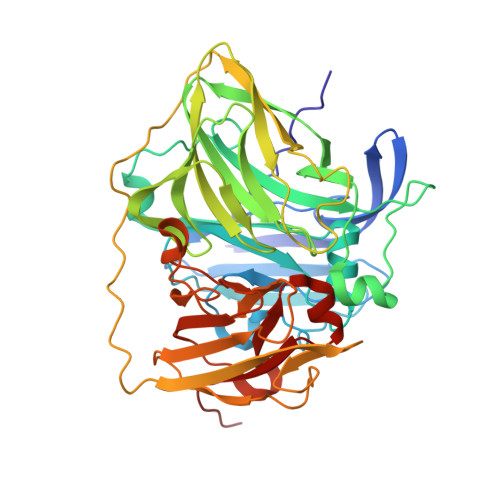Structure and function of the engineered multicopper oxidase CueO from Escherichia coli--deletion of the methionine-rich helical region covering the substrate-binding site
Kataoka, K., Komori, H., Ueki, Y., Konno, Y., Kamitaka, Y., Kurose, S., Tsujimura, S., Higuchi, Y., Kano, K., Seo, D., Sakurai, T.(2007) J Mol Biology 373: 141-152
- PubMed: 17804014
- DOI: https://doi.org/10.1016/j.jmb.2007.07.041
- Primary Citation of Related Structures:
2YXV, 2YXW, 4E9Q, 4E9R, 4E9S, 4E9T - PubMed Abstract:
CueO is a multicopper oxidase (MCO) that is involved in the homeostasis of Cu in Escherichia coli and is the sole cuprous oxidase to have ever been found. Differing from other MCOs, the substrate-binding site of CueO is deeply buried under a methionine-rich helical region including alpha-helices 5, 6, and 7 that interfere with the access of organic substrates. We deleted the region Pro357-His406 and replaced it with a Gly-Gly linker. The crystal structures of a truncated mutant in the presence and in the absence of excess Cu(II) indicated that the scaffold of the CueO molecule and metal-binding sites were reserved in comparison with those of CueO. In addition, the high thermostability of the protein molecule and its spectroscopic and magnetic properties due to four Cu centers were also conserved after truncation. As for functions, the cuprous oxidase activity of the mutant was reduced to ca 10% that of recombinant CueO owing to the decrease in the affinity of the labile Cu site for Cu(I) ions, although activities for laccase substrates such as 2,2'-azino-bis(3-ethylbenzothiazoline-6-sulfonic acid), p-phenylenediamine, and 2,6-dimethoxyphenol increased due to changes in the access of these organic substrates to the type I Cu site. The present engineering of CueO indicates that the methionine-rich alpha-helices function as a barrier to the access of bulky organic substrates, which provides CueO with specificity as a cuprous oxidase.
- Division of Material Sciences, Graduate School of Natural Science and Technology, Kanazawa University, Kakuma, Kanazawa 920-1192, Japan.
Organizational Affiliation:



















